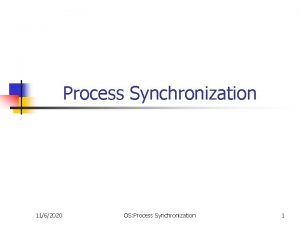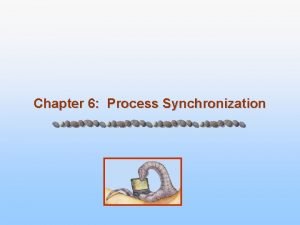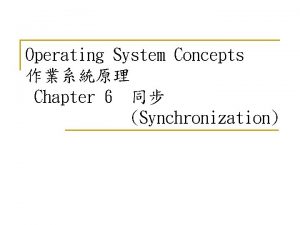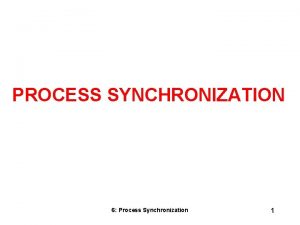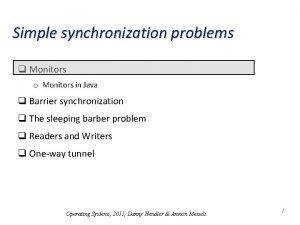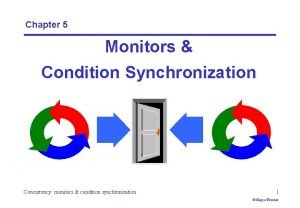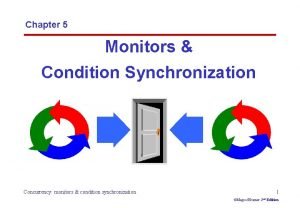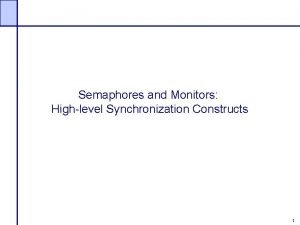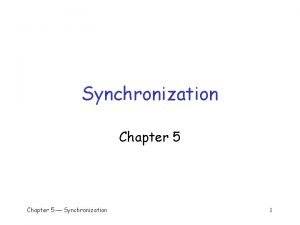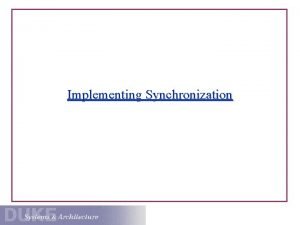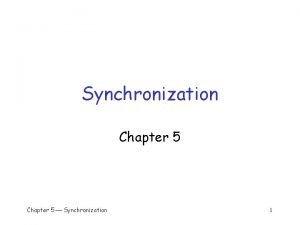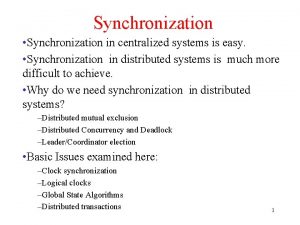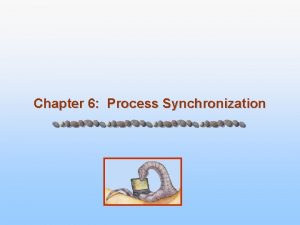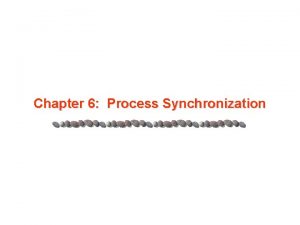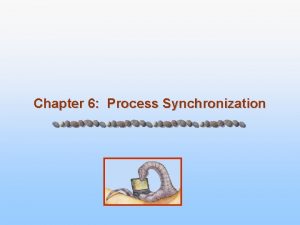Process Synchronization Topics Monitors Simulation of Monitors Checkpoint



![Dining Philosopher Example monitor dining_philosopher { int state[5] /*thinking, hungry and eating */ condition Dining Philosopher Example monitor dining_philosopher { int state[5] /*thinking, hungry and eating */ condition](https://slidetodoc.com/presentation_image_h/1458bc2f22904cbdf559abcb5fa383c3/image-4.jpg)
![Dining Philosopher Example (continued) Method test(int k) { if (state[(k-1)%5] <> eating and state[k]==hungry Dining Philosopher Example (continued) Method test(int k) { if (state[(k-1)%5] <> eating and state[k]==hungry](https://slidetodoc.com/presentation_image_h/1458bc2f22904cbdf559abcb5fa383c3/image-5.jpg)













- Slides: 18

Process Synchronization Topics: Monitors Simulation of Monitors Checkpoint and Recovery

Monitors High -level synchronization construct that allows the safe sharing of an abstract data-type using concurrent processes class monitor-name { variable declarations method declarations initialization }

Monitors (continued) To allow a process to wait within a monitor a condition variable must be declared as condition x, y; The operation x. wait means that the process invoking the command waits (outside the monitor) The operation x. signal resumes exactly one suspended process.
![Dining Philosopher Example monitor diningphilosopher int state5 thinking hungry and eating condition Dining Philosopher Example monitor dining_philosopher { int state[5] /*thinking, hungry and eating */ condition](https://slidetodoc.com/presentation_image_h/1458bc2f22904cbdf559abcb5fa383c3/image-4.jpg)
Dining Philosopher Example monitor dining_philosopher { int state[5] /*thinking, hungry and eating */ condition self[5]; method pickup(int I) {state[I]=hungry; test(I); if (state[I]<>eating) self[I]. wait(); } method putdown(int I) { state[I]=thinking; test( (I-1)%5); test((I+1)%5); }
![Dining Philosopher Example continued Method testint k if statek15 eating and statekhungry Dining Philosopher Example (continued) Method test(int k) { if (state[(k-1)%5] <> eating and state[k]==hungry](https://slidetodoc.com/presentation_image_h/1458bc2f22904cbdf559abcb5fa383c3/image-5.jpg)
Dining Philosopher Example (continued) Method test(int k) { if (state[(k-1)%5] <> eating and state[k]==hungry and state[(k+1)%5]<>eating) {state[k]=eating; self[k]. signal; } Method init { for (I=0; I<5; I++) state[I]=thinking; }

Property of Monitor - At most one process is inside the monitor - We need to have mutual exclusion inside a monitor. - When a process is blocked, it is made to wait outside the monitor. - No process is assumed to die inside a monitor.

Monitor Implementation Using Semaphore Variables: Semaphore mutex(=1), next(=0); int next-count(=0); Each method F (inside a monitor will be replaced by: wait(mutex); F; if (next-count>0) signal(next); else signal(mutex); Mutual Exclusion within a monitor is ensured

Monitor Implementation Using Semaphore For each condition variable x, we have: Semaphore x-sem(=0); int x-count(=0); The operation x. wait can be implemented as: x-count++; if (next-count > 0) signal(next) else signal(mutex); wait(x-sem); x-count--; Value of priority stored with the name of the process that is suspended.

Solaris 2 Operating System Implements a variety of locks to support multitasking, multithreading (including real-time threads), and multiprocessing. Uses adaptive mutexes for efficiency when protecting data from short-code segments Uses condition variables and readerswriters locks when longer sections of code need to access data.

Atomic Transactions Transaction - program unit that must be executed atomically; i. e. , either all the operations associated with it are executed to completion or none are performed. Must preserve atomicity despite possibility of failure. Ensuring atomicity in an environment where failures result in the loss of information on volatile storage.

Log-Based Recovery Write-ahead log - all updates are recorded on the log, which is kept in stable storage; log has following fields: 1: Transaction name 2: Data item name, old value, new value The log has a record of <T_j starts> and either <T_j commits> or <T_j aborts.

Log-Based Recovery algorithm uses two procedures: undo(T_j) - restores value of all data updated by transaction T_j to the old values (log does not contain <T_j commits> but contains <T_j starts> redo(T_j)

Checkpoints-Reduce Recovery Overhead - Output all log records currently residing in volatile storage onto stable storage. - Output all modified data residing in volatile storage to stable storage. - Output log -record <checkpoint> onto stable storage: Recovery routine examines log to determine the most recent transaction T_ j that started executing before the most recent checkpoint took place.

Concurrent Atomic Transactions 1. Serial Schedule -the transactions are executed sequentially in some order. E. g. , Transaction_0: read(a), write(a), read(b), write(b) Transaction_1: read(a), write(a), read(b), write(b) Transaction_0 is executed first

Concurrent Atomic Transactions • Conflicting Operations -O_I and O_ j conflict if they access the same data item, and at least one of the operations is a write operation • Conflict Serializable schedule: schedule that can be swapped into a serial schedule by a series of non-conflicting operations

Example (continued) • sequence: {read(a), write(a)}T_0, {read(a), write(a)}T_1, {read(b), write(b)}T_0, {rea d(b), write(b)}T_1 • Locking Protocols: How locks rae acquired and released. • Shared: T_I has obtained a lock for item Q, then it can read but not write. • Exclusive: read and write Q

Locking Protocol • Two phase locking protocol: • Growing phase: A transaction may obtain locks but not release any. • Shrinking phase: A transaction ma release locks but not acquire new ones. • This protocol ensures conflict serializabilty but not dead-locks

Time Stamp Protocol • Time-stamp ordering scheme - transaction ordering for determining serializability order. With each transaction T_j in the system, associate a unique fixed time stamp, denoted by TS(T_ j). For any new transaction T_k that comes after T_ j, TS(T_k) > TS(T_j). • For each data item value, assign two timestamp values -W-timestamp(Q)- the largest timestamp of any transaction that executed Q successfully.
 Process synchronization in os
Process synchronization in os Process synchronization in os
Process synchronization in os Process synchronization definition
Process synchronization definition Process synchronization definition
Process synchronization definition Chapter
Chapter Flax exam
Flax exam Check point 5800
Check point 5800 Ibm process improvement
Ibm process improvement Ibm checkpoint performance management system
Ibm checkpoint performance management system Sk126613
Sk126613 Kavo killer
Kavo killer French flacs exam
French flacs exam Flacs checkpoint b spanish exam june 2015 answers
Flacs checkpoint b spanish exam june 2015 answers Malloc lab checkpoint
Malloc lab checkpoint Cancer vaccines
Cancer vaccines Cp_log_export
Cp_log_export Checkpoint 12600
Checkpoint 12600 Random variable شرح
Random variable شرح Peter marini
Peter marini
